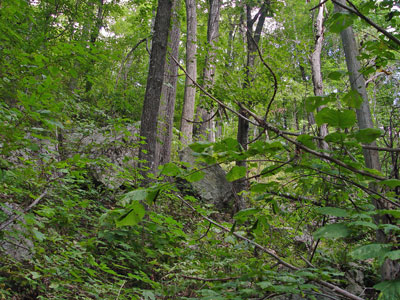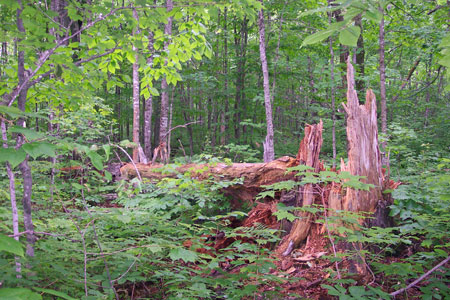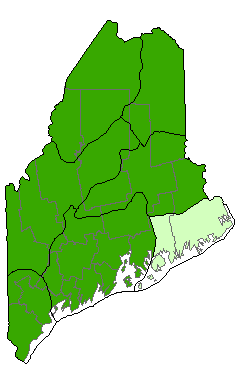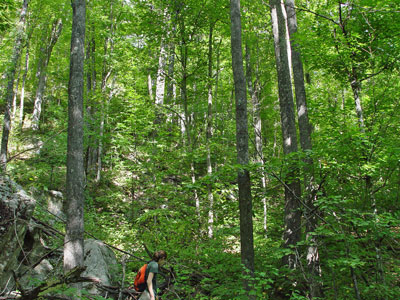DACF Home → Bureaus & Programs → Maine Natural Areas Program → Communities, Plants, and Animals → Natural Community Fact Sheets → Enriched Northern Hardwoods Forest
Printer Friendly Fact Sheet - 880 KB pdf (Get a free copy of Adobe Acrobat Reader)
Enriched Northern Hardwoods Forest
Scientific Name: Maple - Basswood - Ash Forest; State Rank: S3

- Community Description
- Soil and Site Characteristics
- Diagnostics
- Similar Types
- Conservation, Wildlife and Management Considerations
- Distribution
- Characteristic Plants
- Associated Rare Plants
- Associated Rare Animals
- Examples on Conservation Lands You Can Visit
Community Description: Sometimes referred to as “cove forests,” these closed canopy forests are dominated by sugar maple, with beech and/or yellow birch subordinate. Basswood and white ash are typical indicators but are not necessarily abundant, and they are often absent in northwest Maine. The shrub layer is usually sparse and dominated by saplings of the canopy species. The lush herb layer may contain species that are strong indicators of this forest type, such as maidenhair fern, blue cohosh, Dutchman’s breeches, grape fern, spring beauty, and silvery spleenwort. These and many rare species are characteristic of forests with relatively nutrient rich soils. Bryoids are virtually absent. Back to top.
Soil and Site Characteristics: Sites occur on sheltered (concave) hillsides, ravines, stream drainages, or slope bases where nutrients accumulate, often over calcium-bearing bedrock. Slopes often grade from moderate to flat as these forests straddle the base of a hillslope. Small drainage channels may occur in the lower portions, maintaining saturated soils over at least part of the site. Forests upslope often grade to typical northern hardwood forest (Beech - Birch - Maple Forest). Back to top.

Diagnostics: Sugar maple is dominant or co-dominant; white ash and basswood are present in central and southern Maine sites (basswood is absent in northwest Maine); conifers and oaks sparse or absent. Silvery spleenwort, maidenhair fern, blue cohosh, grape fern, Christmas fern, Braun’s holly fern, and Dutchman’s breeches are good herb indicators. Back to top.
Similar Types: The more typical and extensive Northern Hardwoods Forest is dominated by beech, birches, and sugar maple, occurs on less nutrient rich sites, and lacks substantial ash. Back to top.
Conservation, Wildlife and Management Considerations: There are many known mature occurrences of Maple - Basswood - Ash Forests in the state, most with a history of harvesting. However, the market pressures for hardwoods have recently led to heavy cutting of several sites. Typical sites where this community occurs are naturally small and should be buffered from surrounding forest uses. Since this natural community type is most often an inclusion within larger northern hardwood forests, many of the species using northern hardwood forests will also use this type. Back to top.
Distribution: New England - Adirondack Province and Laurentian Mixed Forest Province, with many of the known sites concentrated in the western mountain region of the state. Landscape Pattern: Small Patch, typically occur as 2-20 acres within a larger matrix of northern hardwood forests. Back to top.


Characteristic Plants: These plants are frequently found in this community type. Those with an asterisk are often diagnostic of this community.
- Canopy
- American beech
- Ironwood
- Sugar maple*
- Basswood*
- White ash
- Sapling/shrub
- White ash
- American beech
- Striped maple
- Sugar maple*
- Yellow birch
- Alternate-leaved dogwood*
- Herb
- Christmas fern
- Doll's eyes
- Grape fern
- Maidenhair fern
- Round-leaved violet
- Silvery spleenwort*
- Blue cohosh
- Wild sarsaparilla
- American ginseng
- Broad beech fern
- Goldie's wood-fern
- Male fern
- Pale jewel-weed
- Squirrel-corn
- Wild ginger
- Wild leek
There are no documented rare animals associated with this natural community.
Examples on Conservation Lands You Can Visit
| Example | County |
|---|---|
| Albany Notch, White Mountain National Forest | Oxford Co. |
| Hastings Mountain, White Mountain National Forest | Oxford Co. |
| Miles Notch, White Mountain National Forest | Oxford Co. |
| Peter Mountain, White Mountain National Forest | Oxford Co. |
| Square Dock Mountain, White Mountain National | Oxford Co. |
